Infinity for Authors: 15 Ways to Use Infinity to Write Your Novel
Note: This post was written by one of our lovely users—Johan Dahlberg.
In this post, I explore the many possibilities and advantages of using a project manager to plan, write, edit and publish your novel.
Writing a novel is a little like running a small business. There's a lot to get done, tasks to mark as complete, information to organize and progress to track. From research, outlining and writing character profiles, to collecting contact information and managing feedback from editors and beta readers.
And like any business venture, your success can boil down to how well prepared you are. Unlike a business, however, writing a novel is not about efficient operations and maximizing profits. Instead, it's about staying motivated, actually finishing your novel, and ensuring that it's the best you can possibly make it—no matter how long it takes.
For that, a project manager can be an unconventional but invaluable tool.
The Benefits of Writing Your Novel Using Infinity
I have divided this post into four parts: Planning, Writing, Editing and Publishing. Each part gives you a number of suggested use cases for when a project management tool comes in handy. Once you've started using Infinity for writing novels, you'll wonder how you ever managed without it!
I have also created the Infinity Novel Writing template for authors with folders and tabs already set up to match the uses I suggest in this post. You can preview and download the template here.
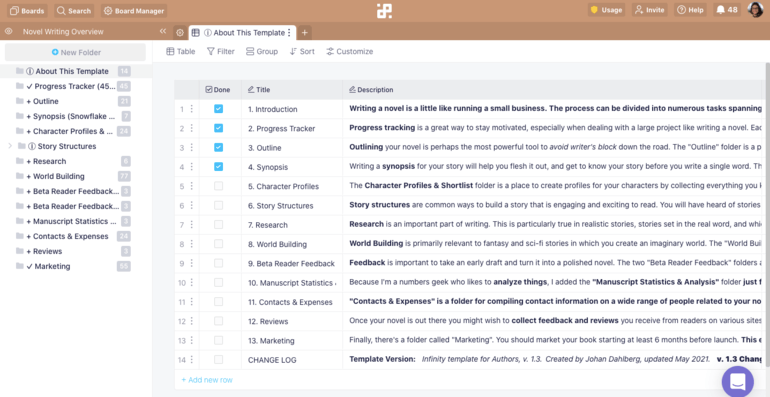
Part 1: Planning
Telling a great story often comes down to proper planning. Character development, foreshadowing, story structure and outlining are all things you can work on before you write a single word of your script.
Every author is unique and some gain their inspiration from winging it, but I would argue that truly great stories need a more systematic approach. Here are a few ways you can use Infinity to help you plan your next novel.
1. Progress Tracking: An All-Inclusive To-Do List
Though every author is unique in their process there are certain things we all do—or should do—at some point. This includes, for example:
- Research
- Writing character profiles
- Creating an outline
- Actually writing the book
- Hiring beta readers
- Implementing feedback from editors
- Obtaining an ISBN (self-publishing)
- Submitting to agents & publishers (traditional publishing)
You can use Infinity to set up a simple but project-spanning to-do list that covers the entirety of your book project. Use the checkbox attribute to mark items as "done", or labels and the Kanban view to move tasks from To Do to Doing to Done.
With an actionable to-do list you always know what you could or should do next, and can see at a glance how far you've come—an excellent motivator for times when writing feels like a chore.
All of the above tasks can also be handled with Infinity on an individual level, and many of the other points in this post are about the tasks listed above.
Tip: Not sure what to include on your to-do list? I have created an Infinity Novel Writing template which has a "Progress Tracker" folder. It contains 45 steps most authors go through at some point in their writing process, a useful tool to learn what it takes to write a novel.
2. Drag & Drop Outline
An outline is perhaps the most important tool for any author to have. Opinions on outlining are divided, as some writers swear by the benefit of "winging it". They discover their own story as they go, and gain their inspiration from learning things as they write.
But the truth is that it's very difficult to actually finish a story if you don't know where you're going. If you've started writing a lot of novels but haven't actually finished one, a lack of a proper outline (and discipline) may very well be the culprit. I would even argue that it's the #1 cause of writer's block. So yes, I'm definitely a proponent of having an outline.
How detailed your outline is, however, is another story. We can divide outlines into three categories:
- Tentpole Outline: A list of only the major events in the story, including the beginning, ending and a number of key scenes in the middle. What happens between each "tent pole" is discovered during the writing process.
- Scene Outline: A list of (nearly) every single scene in the story. This outline can be very long, but allows for building an exciting and elaborate story before writing a single word of the actual manuscript.
- Synopsis: Rather than listing plot points, a synopsis is a written summary of the entire story. You can write a synopsis to get to know your own story and later add the plot and subplots you come up with to your outline, or you can use the synopsis as your only form of outlining.
I'm very much in favor of a detailed outline, because having one means you can write scenes out of order without losing track of where you are or how far you've come. When writer’s block strikes, simply move on to a scene you’re passionate about right now. The pieces will soon fall into place.
Infinity is unrivaled when it comes to creating a strong and flexible outline. Why? Because you can use drag & drop, labels, and the filter and group features to manage it.
More specifically, in Infinity you can:
- Create a folder titled "Outline".
- Add every scene you want to include in your story as an item.
Tip: Use a short text attribute to give the scene a title or one-sentence summary, and a long text attribute to include more information about the scene. - Assign a label to each scene based on the chapter the scene belongs to (Chapter 1, Chapter 2, etc.).
Tip: Infinity has 16 preset label colors, but you can of course reuse the same color or define your own if your novel has more than 16 chapters. - Use the "Group" function to view scenes grouped based on their chapter label.
- Use drag & drop to move scenes around—including between chapters and in chronological order within each chapter.
- Assign a label for each character that is in a scene.
Tip: Create a set of labels called "Characters" with unique color-coded labels named after the characters in your novel. - Use the "Filter" feature to view only scenes with a specific character in them. This is incredibly useful when working on subplots and parallel storylines!
Alternatively, if you prefer the tent pole approach to outlining, you can create an item for each chapter in your book and write a brief summary of the main events in each one.
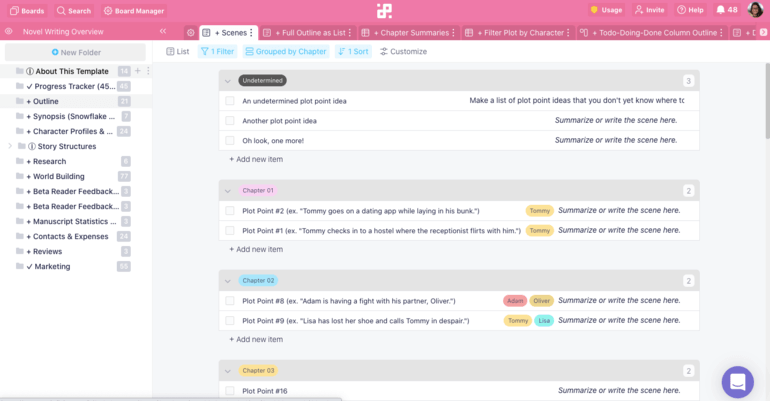
3. A Database of Character Profiles (AKA Character Bible)
A great story demands fascinating characters and properly executed character development. Characters who are unique in looks and personality are more memorable, and most if not all of your characters need to have goals and motivations within the story, as well as both strengths and weaknesses/flaws. For a story to be engaging, a character should also not be the same at the end as they were when we first met them—they should go through a process of change.
To help you plan for and achieve all this, it's beneficial to write deep character profiles. Depending on how deep you want to go, a character profile can include:
- A written summary of who your character is.
- Basic information like name, age, gender, looks, personality traits, etc.
- The backstory for your character.
- A summary of your character's goals and motivations within the story—what do they want to achieve, why, and how will they do it?
- A mini synopsis of character subplots.
- Supporting images.
Here's what you can do in Infinity:
- Set up a folder called "Character Profiles".
- Using the List view, add an item for each of your characters.
- Click an item to set up the attributes you want your profiles to have. Suggested attributes include:
- Short text boxes for the name, age, gender and other basic information (one box for each point).
- Long text boxes for written summaries (including looks, personality traits, backstory, goals & motivations, and a mini subplot synopsis).
- Attachments to upload images for a visual representation of the character you envision.
- Labels with a unique color-coded label for each character (with the label being named after the character)—you can use the same label set you created when you made your outline.
- Create additional tabs to view your database of character profiles in different ways. For example, you can use the Kanban view to see each character as a card where more information, including larger profile images, is visible without having to click on a name to open up the full profile.
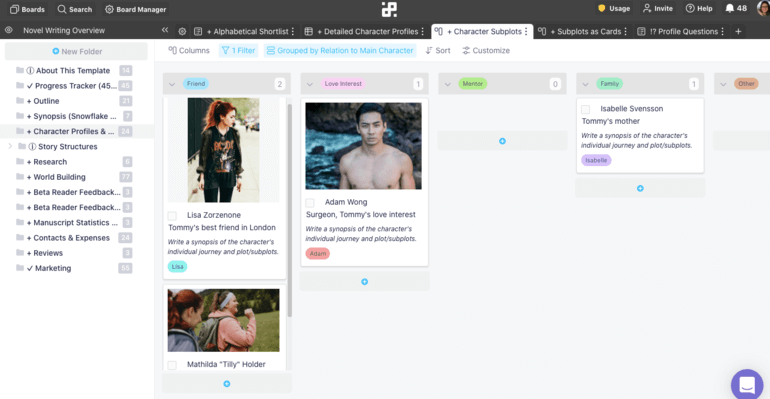
4. Define & Compile Research
Research is crucial to any story set in the real world. Doing proper research makes your story more credible, but also easier to write well. When we don't know what we're talking about we tend to "rush" the writing, which can make your script feel less complete, less engaging, and less authentic.
Examples of things you may want to research include:
- Real-life places, cities and other settings
- Occupations that your characters have
- Cultures
- Minorities like characters with an ethnic background, a disability, or a sexual orientation different from your own
In Infinity, set up a folder called "Research" and add an item for every topic you can think of that you'll need to learn more about. You can use the Attachment attribute to upload photos of real-world locations, the Link attribute to link to sources online, and the Text attribute to take notes.
5. Do Worldbuilding for Fantasy & Sci-Fi
Worldbuilding is the art of creating the imaginary world in which your story is set, particularly relevant to the genres of fantasy and sci-fi. This includes everything from drawing maps and political borders, to coming up with unique cultures and defining transportation systems, healthcare, common occupations, habits and customs, symbols, architecture, and so much more!
Tip: In my Infinity Novel Writing template, I have set up a folder called "World Building". It has tabs with suggested questions about regions in your world, and topics to define for your fictional cultures—from the economy, rulers and politics, to common jobs and the daily lives of the population.
Similarly to research, you can have a folder in Infinity in which you collect all things relevant to your fictional world. Personally, I recommend brainstorming outside of Infinity (in a notebook, digital document or wherever is convenient for you) and using Infinity to compile a database of the things you've already decided upon. You can even upload scanned documents of handwritten notes and drawings!
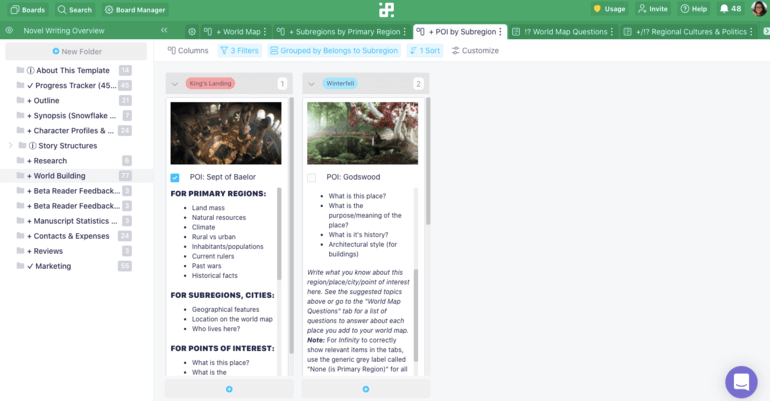
Part 2: Writing
Writing your novel is of course the bulk of the work, and for that you don't need Infinity or a project manager. Just keep writing! There are, however, still ways a work management tool can help you get through the process.
6. Use Your Outline as an Action Plan/To-Do List
In point #2 above I talked about creating an outline in Infinity. Assuming you have a detailed outline, you can use it to track your progress as you write.
Use a Checkbox attribute to mark a scene as "done" when you have fully written it in your manuscript. Even if you write scenes out of order, you always know which parts you've written and what still remains. Writing your novel becomes a matter of laying down the puzzle pieces you've already identified in your Infinity outline.
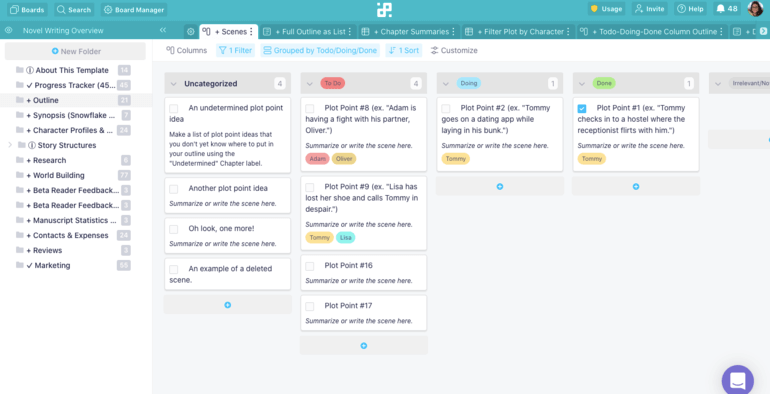
7. Write on the Go
Infinity, like most project management software, is not a text editor, but it can still be used to write on the go. I use it on the bus all the time, to write individual scenes and even full chapters.
You can use the app or web browser on your phone to do this, and because Infinity syncs between all your devices you can pick up where you left when you get home. You can use a "Long Text" attribute to do the writing in, and copy the material to your script when you're ready.
I do most of my on-the-go writing in my outline in Infinity. Because I love detailed outlines where every scene is its own item, I can simply pick a scene I'm passionate about at the moment and type away!
If you want to make things more advanced, you can assign to-do/doing/done labels to items in your outline. That way, you can sort through your list of scenes to find those that you have not yet started working on, or those that you have started working on but not yet finished/copied to your manuscript. Pretty neat, huh?
8. Use Labels to Track Subplots
I already touched on this, but tracking subplots in your outline is an incredible thing to be able to do, one a standard outline in a notebook or Word document can't do for you. Infinity makes this possible thanks to the "Filter" feature.
Assuming you have set up a relatively detailed outline and assigned character labels to individual scenes or plot points, you can select one—or several—characters to view a list of only the scenes in which they are featured.
Particularly when working on a certain subplot, this is a powerful tool to use. As your script grows in length it's easy to get overwhelmed by subplots, to forget the order in which things have happened, or how many chapters ago a certain character said this or that. To avoid plot holes and ensure a logical and correct flow of events, it's highly recommended you focus on and analyze each subplot individually. With Infinity, wrapping your head around a complex story becomes a breeze.
Tip: My Infinity Novel Writing template has the "Outline" folder already set up with a tab specifically for using the filter feature. By sorting scenes using the filter option on a separate tab, you still have easy access to the full outline on your main tab without having to remove the filter.
9. Progress Tracking: Completed Chapters
Even if you don't have a detailed outline, you can still make a list of chapters and mark them as "done" in Infinity. My Infinity Novel Writing template has a chapter tab set up for this, and the project-spanning to-do list I mentioned in point #1 has milestones for writing the 1st, 5th, 10th, etc. chapter.
This is a lighter form of progress tracking that still helps you see how far you've come as you write your novel. It gives you a sense of achievement.
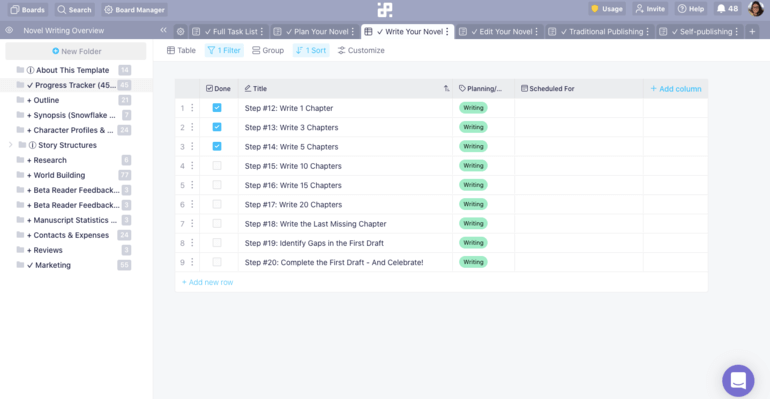
Part 3: Editing
Completing the first draft is a huge milestone, one to celebrate. But it's only half the work. Every novel requires multiple drafts before it's complete.
10. Organize & Implement Feedback
Feedback is crucial to taking a good story and turning it into a great novel. On top of reading and self-editing your own work, you should enlist the help of multiple people and collect feedback from them. These people are called "beta readers".
A good beta reader will help you:
- Provide general feedback on the story as a whole.
- Identify poorly written or rushed sections.
- Identify excessive scenes that don't add value to the plot (kill your darlings).
- Identify larger plot holes.
You can find beta readers in a lot of places, including:
- Friends & Family: There are likely several people in your life who are willing to help for free, and anyone might be the right person to spot something you've overlooked. The downside is that friends and family rarely provide the honest and impartial feedback you need.
- Freelance Sites: Professional or hobby beta readers come relatively cheap, and have the benefit of not knowing you or your story personally. Do a Google search for "beta readers". They're well worth the money!
- Writing Groups: Online groups for writers often have people willing to help you out—but be prepared to pay for their services, as the work of a beta reader is time-consuming.
Once you start getting feedback from multiple sources you need a place to organize it all. That's where Infinity comes in!
In Infinity, you can:
- Set up a folder called "Feedback".
- Create an item for each piece of feedback you think you'll want to implement.
Tip: For a first draft and with multiple beta readers, your feedback list will likely grow very long. This is a good sign! Go through all the feedback and add the stuff that resonates with you to your list. - Assign a chapter label to each feedback point (Chapter 1, Chapter 2, etc.). You created a set of chapter labels when you made your outline (point #2) and can reuse the same set.
- Use the "Group" feature to group feedback items based on the chapter in which the feedback needs to be implemented.
- Use drag & drop to move feedback around in chronological order.
- Assign character labels to sort feedback points based on the characters featured in the scene the feedback applies to—again, this is great for tracking changes made to specific subplots using the "Filter" option in Infinity.
- Use a checkbox attribute to mark individual items as "done" once you have implemented them in your script.
A feedback item or point of feedback could, for example, be "the Sydney harbor needs a more vivid description" or "Tommy needs to mention his feelings for Amy when they talk about what true love means to them". I suggest using a short text attribute for a one-sentence summary of each feedback point, and a long text attribute in which you can expand on the change you need to make and even write entirely new scenes on the go.
As a final note, don't forget that your own feedback and ideas are equally important as those you receive from others. If and when you think of a change you need to make, add it to your feedback list! You are ultimately the one who knows your story best, and a lot of the changes you'll need to implement will come from your own head. Never forget an idea again!
11. Keep Track of Expenses & Contact Details
As you work on your novel over a long time, you will likely be in touch with many people who help you. Specifically, your beta readers and editors, but also book cover designers and other service providers.
Note: An editor is not the same as a beta reader—you should have an editor, but I won't get into that here as you don't need Infinity to manage the work an editor does for you. They will typically use tracked changes directly in your manuscript.
In Infinity you can:
- Set up a folder called "Contacts".
- List all beta readers, editors and other professionals you are considering working with, including friends and family who help you.
- List their contact information in short text boxes.
- Use labels to keep track of who you are actively working with, who you've listed only as a potential candidate to hire, and who you've reached out to but been rejected by.
- Make notes about how people have helped you, for example in a long text attribute.
- Assess the quality of their work—is this someone you should hire again for future book projects?
- Specify how much you've paid each contact to keep track of expenses.
Good Infinity attributes to use in this folder include the standard short and long text boxes, the ratings attribute to assess the quality of the help you received, and the numbers attribute to include and summarize costs.

Part 4: Publishing
With your script complete – presumably after multiple drafts and rounds of feedback – you are ready to present it to the world. This is typically done either through self-publishing or traditional publishing.
12. List Potential Agents & Publishers
Many publishers no longer accept unsolicited submissions, though smaller publishing houses still do. Agents are people who represent authors. They are the gatekeepers to bigger publishers, if you will.
Traditional publishing is usually the most desired option, but it's a highly competitive market. You may need to reach out to dozens of agents and publishers just to get a handful of replies, and you should prepare yourself for a lot of rejections.
That aside, Infinity is a great place to keep track of your communications with agents and publishers.
In Infinity, you can:
- Set up a folder called "Agents & Publishers".
- Make a list of all the publishers you like.
Tip: Check who published your favorite books and books in your genre. Look in your own bookshelf. Go to the library. Do your research online. Find publishers and/or agents who appeal to you and who you think your book would be a good fit for. - Include contact information.
- Use a long text box to write down details, like comments received from a publisher or their submission guidelines.
- Use labels to track each publisher's status, for example: to contact, contacted (but no reply), replied, rejected and accepted!

I recommend sending your script to a handful of publishers/agents at a time, and as your list grows longer and your rejections (yes, they're inevitable even for the best of us) arrive in the coming months, using Infinity to remember who you've already reached out to, what they said, and who you can still try as an alternative is very useful.
Tip: My Infinity Novel Writing template has a "Progress Tracker" folder with 45 steps most authors go through at some point when they write a novel. This list includes a number of steps on self-publishing! If you want to learn more about how to self-publish your novel, that's a good place to start.
13. Email List
An email list is one of the most effective marketing tools. Infinity can be used to keep an online database of potential readers, people who have shown an interest, and sign-ups from your author website. The information can include name, email and other relevant details.
If you have an author website, you should have a sign-up form for a newsletter or similar. You can use Infinity's Form feature to create a form that you can link to or embed on your website. When someone fills out the form, their information is automatically added to the folder in Infinity to which the form belongs.
Similarly, when you meet people who express an interest in your book project, collect their email address to keep them informed. You can add these addresses to your mailing list manually.
14. Marketing
Particularly if you self-publish, marketing is an important aspect of releasing a book. I won't go into too much detail about how to market your book here, but every marketing effort or campaign is a project of its own, and for that, it's natural to use Infinity.
In Infinity, you can:
- Set up a folder called "Marketing".
- Compile a list of your marketing ideas and campaigns.
- Track ad costs and other expenses using the Numbers attribute.
- List book clubs, blogs, reviewers, influencers and other third-party channels to reach out to.
- Use labels to track your communication status with each channel you reach out to.

Many authors struggle with marketing, but if you do decide to make a marketing push and launch several campaigns you will need a place to organize it all and stay on top of things. Infinity was made precisely for such an occasion, and this is perhaps the point on this list that most relates to what a work management tool was designed to do.
15. Collect Reviews
As a final point on this list, I'll talk about reviews. Once your book is out there, you'll hopefully start getting a review or two.
You can list book blogs and professional reviewers as part of your marketing efforts in the previous point, but you can also use Infinity to build a database of all reviews you receive, both professional and from individual readers. Later, you can use quotes from them for your marketing efforts, or use any constructive criticism to revise your novel.
In Infinity, you can:
- Set up a folder called "Reviews".
- Use a short text box for the reviewer's name.
- Use labels to divide reviewers between "professional" (blogs, sites, magazines, etc.) and "reader" (from sites like Amazon or wherever people can buy your book).
- Use long text boxes for "positive feedback" vs. "constructive criticism" – or simply copy the entire review into a single text box.
- Use the rating attribute to assign a 1-5 star rating to each review.
- Use the link attribute to include a link to the full review.
Like when collecting email addresses from potential readers (point #13), you can use Infinity's built-in form feature to collect reviews, or you can add reviews from third-party sites like Amazon manually.
Collecting reviews is not essential to your book writing efforts, but it is nice to have a single place where all your reviews and ratings can be reviewed at a glance, particularly to learn from and improve as you set out to write your next novel.

Summary
Writing a novel is an enormous task, and project management software like Infinity is an invaluable tool to help see you through it. By approaching being an author like running a small business, you can divide a big project into smaller, actionable tasks, and structure your workflow in a way that suits you.
In this post, I've given you some suggested use cases. Use Infinity and my Novel Writing template to overcome writer's block, finish your next novel, and make it the best it can possibly be!
If you're curious about my work, my debut novel Adam & I is out now. Despite being 130,000 words it was written almost exclusively using a combination of Trello (before I discovered Infinity), Infinity and Evernote, with the final manuscript edited in Word. If you want to use my Infinity Novel Writing template for authors, you can find it here.
















